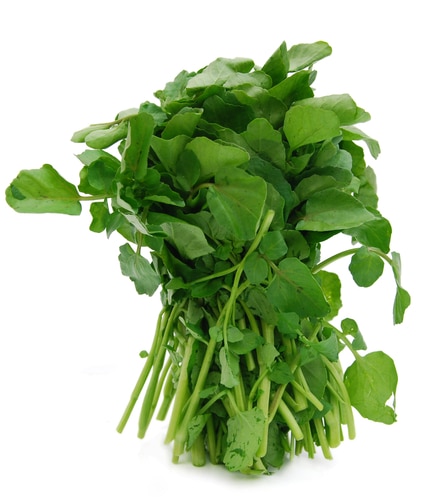
As your body adapts to regular exercise, it becomes more capable of handling free radicals, but if you “overdo” it, you can overwhelm your body’s repair mechanisms. That can lead to burnout and a greater risk for colds and other illnesses since your body can’t recover fast enough. That can put a crimp in your workout routine – and in your health. Is there a way to protect yourself from oxidative stress and the damage it can cause?
Dietary Antioxidants May Help
You already know the importance of eating veggies. Veggies and fruits have natural antioxidants that donate electrons to “rogue” free radicals to aid recovery from oxidative stress, including stress created by exercise. Vegetables of all types, particularly green, leafy ones, broccoli and veggies rich in beta-carotene like carrots are excellent sources of antioxidants, but there’s one you may not have considered – watercress.
The Health Benefits of Watercress
According to a new study published in the British Journal of Nutrition, garden-variety watercress, available at most supermarkets, may be especially “capable” of helping cells repair after a long workout. In a small study, ten healthy men ate 85 grams of watercress a day for two months. During this time, they participated in exhaustive exercise. The men also exercised hard for eight weeks without the advantage of eating watercress daily. The results?
During the period when the men didn’t eat watercress, their cells showed signs of damage including cells called lymphocytes that protect against viral infections like colds. But during the eight weeks when they ate watercress daily, the researchers found no evidence of cellular damage despite the intense exercise sessions the men were doing. They also had higher levels of antioxidants in their bloodstream during the two month period they munched on watercress.
What’s so special about watercress? Other antioxidant-rich vegetables might have a similar benefit, but watercress is an underappreciated source of antioxidants. It’s an official member of the cruciferous family of veggies, a group of vegetables rich in isothiocyanates, compounds that are natural detoxifiers and antioxidants. Plus, watercress is a source of a unique compound called nasturtium. Nasturtium is converted to a powerful anti-cancer chemical called PEITC. In addition, watercress contains high levels of carotenoids and luteins, compounds that are important for healthy vision and for protection against heart disease. At only four calories per cup, watercress is packed with health benefits, especially if you’re watching your weight.
Why Not Add Some Watercress to the Dinner Table?
The unique, peppery taste of raw watercress adds flavor to salads or you can lightly wilt it, and use it as a pizza or pasta topping. Enjoy it as a substitute for lettuce on a sandwich or puree it to make watercress soup. For added health benefits, enjoy watercress soup cold since heating destroys some of its antioxidant benefits.
The Bottom Line?
Next time you’re in the produce section, pick up a bag of watercress to help your cells repair after a workout. You may discover you enjoy its unique flavor and its many health benefits.
References:
Nutraingredients-USA.com. “Antioxidant-Rich Watercress Shows Sports Nutrition Potential”
Science Daily. “Watercress May ‘Turn Off’ Breast Cancer Signal”
World’s Healthiest Foods website.
Related Articles By Cathe:
The Amazing Health Benefits of Watercress
The Tasty Art of Eating Watercress
Can Eating Leafy Greens Improve Your Exercise Performance?
6 Lesser Known Vegetables with Powerful Health Benefits
5 Foods that Help Lower Blood Pressure
Are You Getting Enough Iodine in Your Diet?
Top 5 Vegetables Based on Nutrient Density
7 Ways to Boost the Nutrient Content of Your Meals Without Adding More Calories

